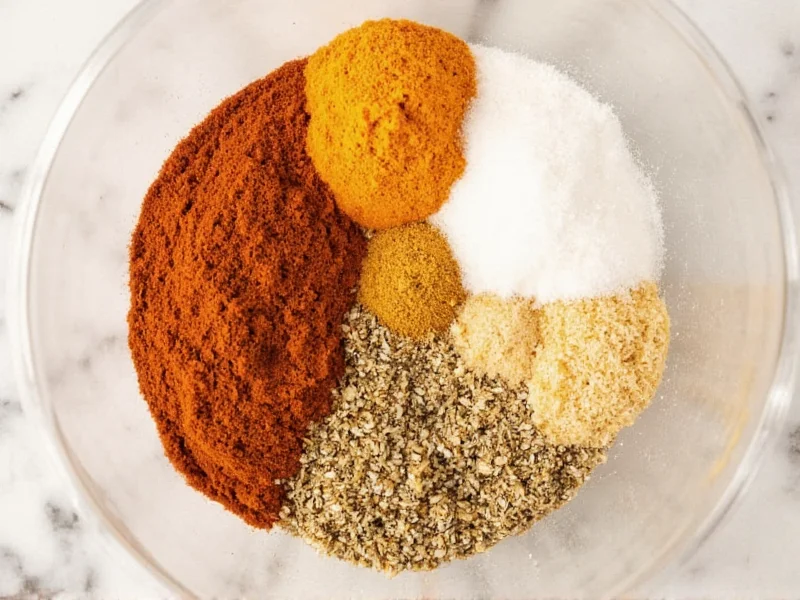Chicken soup transforms from ordinary to extraordinary with the right spice selection and technique. While broth quality forms the foundation, spices provide the aromatic complexity that defines exceptional chicken soup. Understanding which spices complement poultry, when to add them, and how they interact creates restaurant-quality results at home. This guide details precise spice measurements, timing considerations, and flavor combinations that elevate your chicken soup from basic comfort food to a memorable culinary experience.
Core Spices for Perfect Chicken Soup
Every exceptional chicken soup recipe begins with a carefully balanced spice foundation. These ingredients work synergistically to enhance the natural flavors of chicken without overpowering the delicate broth.
Essential Aromatic Base
The holy trinity of chicken soup spices consists of thyme, parsley, and bay leaves. Thyme's earthy, slightly minty flavor penetrates the broth deeply, especially when added early in cooking. French thyme works best for classic preparations, while lemon thyme adds a bright citrus note for spring variations. Parsley contributes fresh, grassy notes best added near the end of cooking to preserve its vibrant flavor. Bay leaves provide subtle complexity that develops slowly—always remove them before serving as they become bitter when overcooked.
Flavor Enhancers
Garlic and onion powder form the savory backbone of professional chicken soup. Unlike fresh garlic which can turn bitter when simmered too long, garlic powder dissolves completely into the broth, providing consistent flavor. Onion powder offers similar advantages over fresh onions, delivering sweet, caramelized notes without texture. For authentic depth, add these during the initial sauté phase with your mirepoix (celery, carrots, and onions).
| Spice | Amount per 4 Cups Broth | When to Add | Flavor Contribution |
|---|---|---|---|
| Dried thyme | 1/2 teaspoon | Beginning of simmer | Earthy, herbal depth |
| Fresh parsley | 2 tablespoons chopped | Last 10 minutes | Grassy freshness |
| Bay leaves | 1 leaf | Beginning of simmer | Subtle complexity |
| Black pepper | 1/4 teaspoon | Beginning of simmer | Warmth, pungency |
| Garlic powder | 1/4 teaspoon | With mirepoix | Savory umami |
Advanced Spice Combinations for Gourmet Results
Once you've mastered the basics, experiment with these professional spice combinations to create distinctive chicken soup variations. Each profile works with specific cultural interpretations of this classic dish.
Mediterranean-Inspired Chicken Soup
Add 1/4 teaspoon dried oregano and a pinch of red pepper flakes along with your foundational spices. Finish with lemon zest and a tablespoon of fresh dill. This combination creates bright, herbaceous notes that pair beautifully with added white beans or orzo pasta. The lemon zest should go in during the last five minutes of cooking to preserve its volatile oils.
Asian Fusion Chicken Soup
For an umami-rich variation, add one-inch of fresh ginger (sliced thin), 1 star anise pod, and 1/4 teaspoon toasted sesame oil. Replace black pepper with white pepper for authentic flavor. Add these spices after sautéing your aromatics but before adding broth. Remove the ginger and star anise before serving. This profile works exceptionally well with added shiitake mushrooms and bok choy.
Eastern European Comfort Style
Incorporate 1/4 teaspoon marjoram and a pinch of allspice with your base spices. Add fresh dill and a squeeze of lemon juice at the end. This combination creates the distinctive flavor of traditional Jewish chicken soup. For authentic results, include a piece of parsnip during simmering—it adds natural sweetness without overpowering other flavors.
Timing Techniques for Maximum Flavor Impact
Professional chefs understand that when you add spices matters as much as which spices you use. Dried herbs release their oils slowly during simmering, making them ideal for early addition. Fresh herbs contain volatile compounds that evaporate with prolonged cooking, so add them near the end.
For optimal results, follow this spice timing sequence:
- Add dried herbs, bay leaves, and whole spices when you add the broth
- Incorporate garlic and onion powder when sautéing vegetables
- Stir in fresh herbs during the last 10-15 minutes of cooking
- Add finishing touches like citrus zest or delicate spices in the last 5 minutes
Never add salt initially—season in stages, tasting as the soup reduces. Broth concentration changes during simmering, so final seasoning adjustments should happen in the last 15 minutes of cooking. This approach prevents over-salting and allows precise flavor balancing.
Avoiding Common Spice Mistakes
Even experienced home cooks make these frequent errors when seasoning chicken soup:
Overpowering Delicate Flavors
Using too much of strong spices like cayenne, cloves, or curry powder overwhelms chicken's subtle flavor. Start with half the recommended amount—you can always add more, but you can't remove excess spice. For bold spices, add incrementally and allow 10 minutes for flavors to integrate before tasting again.
Misunderstanding Fresh vs. Dried Herb Ratios
Many cooks don't realize that dried herbs are typically three times more potent than fresh. Using equal amounts creates imbalance. Remember this conversion: 1 teaspoon dried herbs = 1 tablespoon fresh herbs. When substituting, adjust quantities accordingly to maintain proper flavor balance.
Neglecting Acid Balance
Professional soups always include an acid component to brighten flavors. Add 1-2 teaspoons of apple cider vinegar, lemon juice, or white wine during the last 10 minutes of cooking. This simple step transforms flat-tasting broth into vibrant soup. The acid doesn't make the soup taste sour—it enhances all other flavors through contrast.
Special Considerations for Dietary Needs
Adapting chicken soup spices for dietary restrictions requires thoughtful substitutions without sacrificing flavor.
Low-Sodium Options
When reducing salt, boost flavor with 1/4 teaspoon celery seed, 1/8 teaspoon turmeric, and extra fresh herbs. These ingredients provide savory depth without sodium. Roasting vegetables before adding to the soup also creates natural sweetness and complexity that compensates for reduced salt.
Allergy-Friendly Variations
For those avoiding common allergens, substitute standard spice blends with single-ingredient spices. Many commercial blends contain hidden allergens like gluten or dairy. Create your own custom blend using pure spices to ensure safety while maintaining flavor complexity.











 浙公网安备
33010002000092号
浙公网安备
33010002000092号 浙B2-20120091-4
浙B2-20120091-4